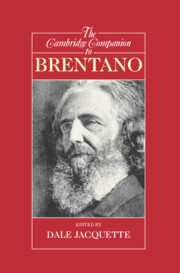Book contents
- Frontmatter
- 1 Introduction
- 2 Brentano’s relation to Aristotle
- 3 Judging correctly
- 4 Brentano on the mind
- 5 Brentano’s concept of intentionality
- 6 Reflections on intentionality
- 7 Brentano’s epistemology
- 8 Brentano on judgment and truth
- 9 Brentano’s ontology
- 10 Brentano’s value theory
- 11 Brentano on religion and natural theology
- 12 Brentano and Husserl
- 13 Brentano’s impact on twentieth-century philosophy
- Bibliography
- Index
9 - Brentano’s ontology
from conceptualism to reism
Published online by Cambridge University Press: 28 May 2006
- Frontmatter
- 1 Introduction
- 2 Brentano’s relation to Aristotle
- 3 Judging correctly
- 4 Brentano on the mind
- 5 Brentano’s concept of intentionality
- 6 Reflections on intentionality
- 7 Brentano’s epistemology
- 8 Brentano on judgment and truth
- 9 Brentano’s ontology
- 10 Brentano’s value theory
- 11 Brentano on religion and natural theology
- 12 Brentano and Husserl
- 13 Brentano’s impact on twentieth-century philosophy
- Bibliography
- Index
Summary
CONCEPTUALISM (1862–1874)
It is often claimed that the beginnings of Brentano's ontology were Aristotelian in nature; but this claim is only partially true. Certainly the young Brentano adopted many elements of Aristotle's metaphysics, and he was deeply influenced by the Aristotelian way of doing philosophy. But he always interpreted Aristotle's ideas in his own fashion. He accepted them selectively, and he used them in the service of ends that would not have been welcomed by Aristotle himself. The present paper is an exposition of the development of Brentano's ontology, beginning with the Lectures on Metaphysics first delivered by Brentano in Würzburg in 1867 and concluding with his late work from 1904-17.
Being and truth
Aristotle distinguished various ways in which being can be predicated.1 There is first of all the ontologically serious use of the word “is”: being in the sense of the categories, also called “real being” in what follows. The two other ways of saying “is” relate respectively to what Aristotle called “purely accidental being” and “being in the sense of being true.” It is especially the notion of being in the sense of being true that will concern us in what follows.
- Type
- Chapter
- Information
- The Cambridge Companion to Brentano , pp. 197 - 219Publisher: Cambridge University PressPrint publication year: 2004
- 11
- Cited by



